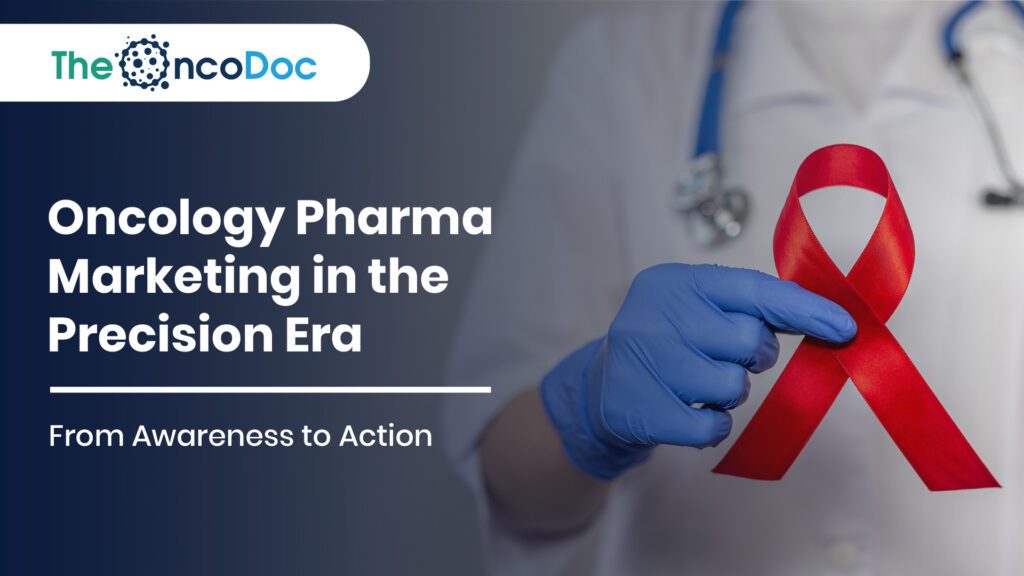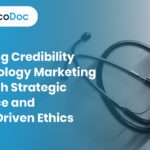Introduction: Oncology Marketing at a Crossroads
The global oncology market is expected to cross USD 350 billion by 2030, driven by breakthroughs in precision medicine, immunotherapies, and AI-enabled diagnostics. Yet, this rapid expansion brings a new challenge: how can pharma companies meaningfully engage oncologists, multidisciplinary care teams, and patients without overwhelming them with generic promotional noise?
In the past, oncology marketing emphasized drug brand visibility, educational seminars, journal ads, and sales representative visits dominated strategy. Today, the environment is shifting. With oncologists facing information overload, regulatory scrutiny tightening, and clinical guidelines changing almost quarterly, pharma must transition from transactional engagement to transformational partnership.
The answer lies in data-driven personalization, AI-enabled clinical decision support, and patient-centric resources. This article outlines a comprehensive roadmap for oncology pharma marketing in the precision era,covering digital transformation, value-based engagement, ecosystem collaboration, and real-world evidence, with actionable insights and real-world examples.
1. Rethinking the Oncology Marketing Model: From Volume to Value
Traditional oncology marketing often prioritizes reach metrics, conference attendance, brochure distribution, or website hits. But in today’s oncology practice, impact matters more than impressions.
Key shift: Campaigns must align with clinical utility. Instead of “How many saw our message?”, the question becomes, “Did our engagement improve a clinical decision or patient outcome?”
A recent 2025 oncology engagement survey (India, n=1,500 oncologists) revealed:
Insight: Oncology pharma marketing success now lies in embedding value directly into clinical workflows, positioning the brand as a problem solver rather than a product promoter.
2. AI-Powered Personalization: Engaging the Oncologist as a Micro-Audience
The oncology landscape is highly segmented, medical oncologists, surgical oncologists, radiation oncologists, hemato-oncologists, and supportive care specialists have vastly different information needs.
AI-powered CRM systems now enable hyper-personalized engagement:
- Behavior tracking: Identifying preferred content formats (videos, infographics, long-form PDFs)
- Timing optimization: Sending updates when oncologists are most responsive
- Specialty-specific targeting: Delivering only relevant trial data or case updates
Example:
- A Mumbai-based medical oncologist prefers early-morning WhatsApp updates with interactive clinical flowcharts
- A Jaipur-based hemato-oncologist engages better with evening webinars and downloadable trial summaries
Action for Pharma: Build dynamic content engines that tailor delivery by specialty, location, and preference signals.
3. Co-Creating Clinical Decision Tools: Pharma as a Partner in Care
The most impactful oncology brands are those that become tools, not just therapies. AI enables pharma companies to co-create real-time, adaptive decision aids for oncologists:
- Treatment pathway calculators: Customizing regimens based on tumor genetics, stage, and comorbidities
- Side-effect monitoring dashboards: Flagging adverse trends from patient-reported data
- Genomic interpretation engines: Translating biomarker reports into treatment options
Case Study:
A lung cancer brand partnered with pathology labs to integrate an EGFR mutation detection API. Outcomes included:
- 2,800+ oncologists onboarded in 6 months
- 25% faster diagnosis-to-treatment timeline
- 18% increase in correct first-line therapy selection
4. Field Force 2.0: Equipping Representatives with AI Insights
While digital engagement is rising, field representatives remain essential in oncology. The difference is their role:
- Old model: Delivering static product messages
- New model: Curating personalized clinical experiences
AI enablement tools can transform field visits:
- CRM dashboards tracking content engagement history for each oncologist
- Adaptive detailing apps adjusting the pitch in real-time
- Voice-note summaries customized per oncologist
This approach leads to fewer cold rejections and more meaningful discussions.
5. Multilingual Engagement: Building Trust Beyond Metros
India’s cancer burden spans Tier 2 and Tier 3 cities, where English-language campaigns miss a large portion of the audience. AI + localization technology enables multi-language engagement:
- Regional language treatment explainer videos (Marathi, Bengali, Kannada)
- WhatsApp chatbots answering FAQs in multiple dialects
- Dietary guides tailored to local food preferences
Impact: A Marathi-language breast cancer awareness campaign increased screening participation by 20% in semi-urban districts.
6. Real-World Evidence: Strengthening Credibility with Local Data
RCTs remain gold standard, but oncologists increasingly value real-world evidence (RWE), especially in diverse populations.
Pharma can use AI to generate localized dashboards:
- Heatmaps of adverse events by region
- Survival outcome trends across public vs. private hospitals
- Adherence trackers by demographic
Insight: Localized RWE builds trust and relevance, positioning pharma as a partner in clinical reality.
7. Expanding Beyond Oncologists: Engaging the Cancer Care Ecosystem
Modern oncology care is multidisciplinary, nurses, pharmacists, nutritionists, palliative care specialists, and caregivers all influence outcomes.
High-value tools for extended teams:
- Drug safety checklists for pharmacists
- AI-powered nutrition modules for dieticians
- Palliative care referral directories for social workers
- Patient support kits (videos, journals, caregiver networks)
This broadens brand reach without direct promotion, instead embedding it in care enablement.
8. Oncology Learning Communities: Creating Platforms for Peer Collaboration
Clinicians prefer peer-driven knowledge exchange over top-down marketing. Pharma can enable:
- Virtual tumor boards for multi-specialty case discussions
- Specialty-specific CME forums
- Real-case databases with AI-powered search
Example: A pharma-enabled “Oncology Knowledge Hub” facilitated 2,500+ oncologists sharing anonymized cases, with 85% reporting a positive impact on decision-making.
9. Ethical AI Marketing: Innovation Within Compliance
AI must operate within regulatory and ethical boundaries:
- Transparency: Tools must explain data sources clearly
- Neutrality: Avoid direct therapeutic recommendations
- Privacy: Ensure patient data encryption and anonymity
Ethically aligned AI builds long-term trust among clinicians and regulators.
10. Measuring Success: From Campaign Reach to Clinical Impact
Traditional KPIs (clicks, impressions) are outdated in oncology. Modern metrics include:
- Tool usage frequency (How often oncologists revisit the tool)
- Decision influence rate (Cases where the tool impacted therapy choice)
- Patient understanding and adherence improvements
Key Insight: ROI in oncology is now Return on Outcomes, success is defined by real-world impact.
11. Digital Therapeutics Integration: Beyond the Drug Bottle
Digital therapeutics (DTx) are emerging as a new pillar of oncology care. While drugs remain the core of treatment, digital solutions that guide patients between clinic visits can significantly improve adherence and quality of life.
Opportunities for pharma marketing:
- Adherence trackers: Mobile apps reminding patients about oral chemotherapy schedules or immunotherapy sessions
- Symptom diaries: AI-assisted tools that detect concerning trends (fever, fatigue, appetite loss) and alert care teams
- Lifestyle management modules: Nutrition, exercise, and stress-reduction programs personalized to cancer type and treatment phase
Example: A myeloma drug brand partnered with a digital health startup to launch an AI-based fatigue monitoring app. Results after 6 months:
- 17% increase in therapy adherence
- 12% reduction in unplanned hospital visits
- Higher patient satisfaction scores (84%)
Takeaway: Marketing can highlight drug + digital solution ecosystems as a comprehensive care package, reinforcing brand value beyond efficacy.
12. Patient-Centric Storytelling: Humanizing the Science
Oncology communication is often data-heavy and emotionally distant. Yet, cancer remains deeply personal for patients and caregivers. Storytelling bridges this gap, transforming data into relatable narratives.
Approaches for pharma:
- Sharing real patient journeys (with consent) to demonstrate treatment outcomes
- Using infographic timelines to simplify complex trial data for lay audiences
- Featuring caregiver experiences to highlight support program benefits
Case Example:
A breast cancer therapy campaign combined 3 survivor stories in regional languages, each linked to the same treatment journey but different socioeconomic contexts. This led to:
- 23% increase in patient enrollment in support programs
- 15% growth in inbound patient helpline calls
Insight: Storytelling builds emotional connection and trust, crucial for oncology brands in competitive markets.
13. Pharmacoeconomics & Access Marketing: Addressing Cost Barriers
In oncology, cost remains a critical decision factor, especially in developing markets like India. Pharma marketing must address affordability and accessibility head-on, integrating pharmacoeconomics into brand positioning.
Tactics:
- Highlight cost-effectiveness using RWE-based outcomes
- Promote tiered pricing models for public vs. private hospitals
- Partner with insurance and CSR foundations for co-pay assistance programs
Example:
A colorectal cancer drug launched a patient affordability program in 10 Tier 2 cities:
- 40% more patients initiated therapy
- Dropout rates reduced by 18% due to financial support continuity
Key Point: In oncology, access programs are not just patient goodwill, they are strategic market growth drivers.
14. Omnichannel Engagement: Building a Seamless Experience
Oncology specialists access information through multiple touchpoints, emails, conferences, webinars, apps, and field visits. The future of marketing is not multi-channel, but omnichannel, where all interactions are synchronized for a consistent experience.
Example of an Omnichannel Oncology Journey:
- Oncologist attends a virtual CME webinar → Receives follow-up email with case study
- Field representative visits clinic → Demonstrates AI tool linked to webinar topic
- Oncologist logs into brand app → Finds personalized treatment guideline updates
Impact:
- Consistency in message delivery builds brand trust
- Data from each channel feeds into AI, refining future personalization
15. Sustainability and ESG in Oncology Pharma Marketing
Pharma marketing is increasingly being judged not just by clinical outcomes but also by ethical, social, and environmental responsibility. Oncology brands can differentiate by embedding sustainability in their campaigns.
ESG-aligned oncology marketing actions:
- Paperless detailing to reduce environmental footprint
- Green supply chain practices for oncology injectables
- Community outreach on cancer prevention and early detection in underserved areas
Example:
An immunotherapy brand launched an eco-friendly conference booth (digital displays only, recyclable materials), combined with free cervical cancer screening drives. This generated positive PR coverage and brand goodwill.
16. The Future: AI + Genomics + Pharma Collaboration
The next frontier in oncology marketing will integrate AI-driven predictive genomics into brand ecosystems.
How this could work:
- Genomic analytics platforms predict patient subgroups with better drug response
- Pharma provides oncologists with biomarker-driven treatment recommendations (brand-agnostic tools that include their product as an option)
- Collaborative partnerships with genetic testing labs create early engagement points in the patient journey
Forecast Impact:
- Earlier diagnosis = larger eligible patient pool
- Faster decision-making = improved treatment outcomes
- Brand trust grows as pharma positions itself as a scientific partner in precision oncology
17. Navigating Regulatory Complexity: Strategic Compliance as a Competitive Edge
Oncology pharma marketing operates in one of the most tightly regulated environments in medicine. Every claim, communication, and engagement strategy must withstand scrutiny from health authorities, medical councils, and institutional ethics boards.
Rather than viewing compliance as a limitation, leading companies are reframing it as a strategic differentiator:
Best practices in regulatory-aligned marketing:
- Evidence-based content: Every claim backed by peer-reviewed data
- Transparent data sharing: Real-world evidence presented without selective reporting
- Clear boundaries on engagement: Educational events structured around therapy areas, not brands
Example:
An immuno-oncology brand ran brand-agnostic tumor board series across 15 cities. Because the program followed strict compliance rules, it earned endorsement from national oncology societies, adding credibility to the brand indirectly.
Takeaway: A reputation for integrity in compliance becomes a long-term marketing asset.
18. Harnessing Social Media for Oncology Knowledge Dissemination
While oncology is a highly specialized field, social media has emerged as a serious professional learning channel for clinicians. Platforms like LinkedIn, Twitter (X), and private WhatsApp groups are now hubs for conference highlights, clinical updates, and expert opinions.
Pharma opportunities in oncology social engagement:
- Partnering with Key Opinion Leaders (KOLs) for guideline updates
- Hosting LinkedIn Live sessions on breakthrough therapies
- Sharing summarized trial outcomes in infographic formats
Caution: Social engagement in oncology must avoid direct-to-patient promotional risks, focusing instead on educational credibility.
Example:
A gastrointestinal oncology brand used Twitter-based clinical polls to spark discussion on new treatment sequences, gaining 2,000+ oncologist interactions in 3 months.
19. Data Interoperability: Integrating Pharma Tools into Hospital Systems
One of the most underused yet transformative marketing strategies in oncology is system integration. Many pharma-developed tools fail because they exist in standalone silos, requiring oncologists to switch systems.
Future-ready approach: Embed pharma-developed decision aids, adherence trackers, or RWE dashboards directly into hospital EMRs.
Example:
A leukemia treatment brand integrated a drug-interaction alert system within a major cancer hospital’s EMR. The system automatically flagged contraindicated combinations. This:
- Improved prescribing safety by 22%
- Strengthened the hospital’s perception of the brand as a safety innovator
Insight: When pharma tools live inside the oncologist’s workflow, adoption becomes natural, and brand association strengthens silently.
20. The Rise of Micro-Marketing in Rare Oncology Segments
While major cancers like breast, lung, and colorectal dominate the oncology market, rare cancers (sarcoma, glioblastoma, cholangiocarcinoma) represent an opportunity for specialized, high-impact marketing.
Micro-marketing strategies:
- Highly targeted CME programs for small specialist groups
- Curated patient registries for rare tumor subtypes
- Collaborations with specialized cancer advocacy groups
Case Study:
A targeted therapy for ALK-positive lung cancer engaged only 120 oncologists in India but built a deep loyalty base, achieving 75% prescription share within the niche market.
Key Point: Rare oncology micro-marketing focuses on depth, not breadth, precision engagement for precision medicine.
Conclusion: Oncology Pharma’s New Identity
In the precision era, oncology pharma marketing must evolve from promotion to partnership:
- Build tools, not just campaigns
- Enable care ecosystems, not just sales channels
- Measure clinical impact, not just impressions
The brands that succeed will be those that embed themselves into moments of care, becoming trusted allies in the fight against cancer.
👉 Bottom Line: Don’t just market a drug, empower every step of the patient journey.
The Oncodoc team is a group of passionate healthcare and marketing professionals dedicated to delivering accurate, engaging, and impactful content. With expertise across medical research, digital strategy, and clinical communication, the team focuses on empowering healthcare professionals and patients alike. Through evidence-based insights and innovative storytelling, Hidoc aims to bridge the gap between medicine and digital engagement, promoting wellness and informed decision-making.



